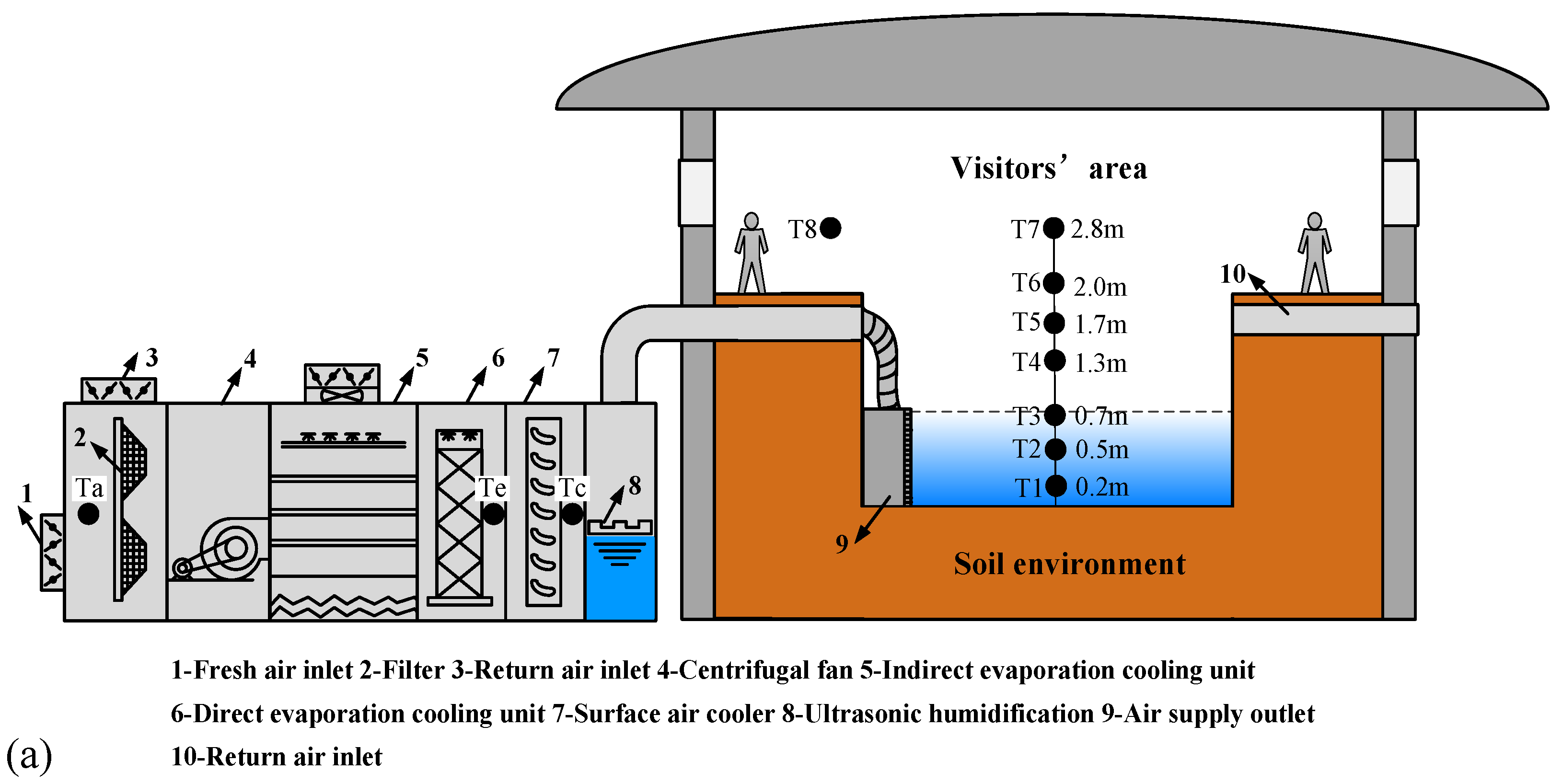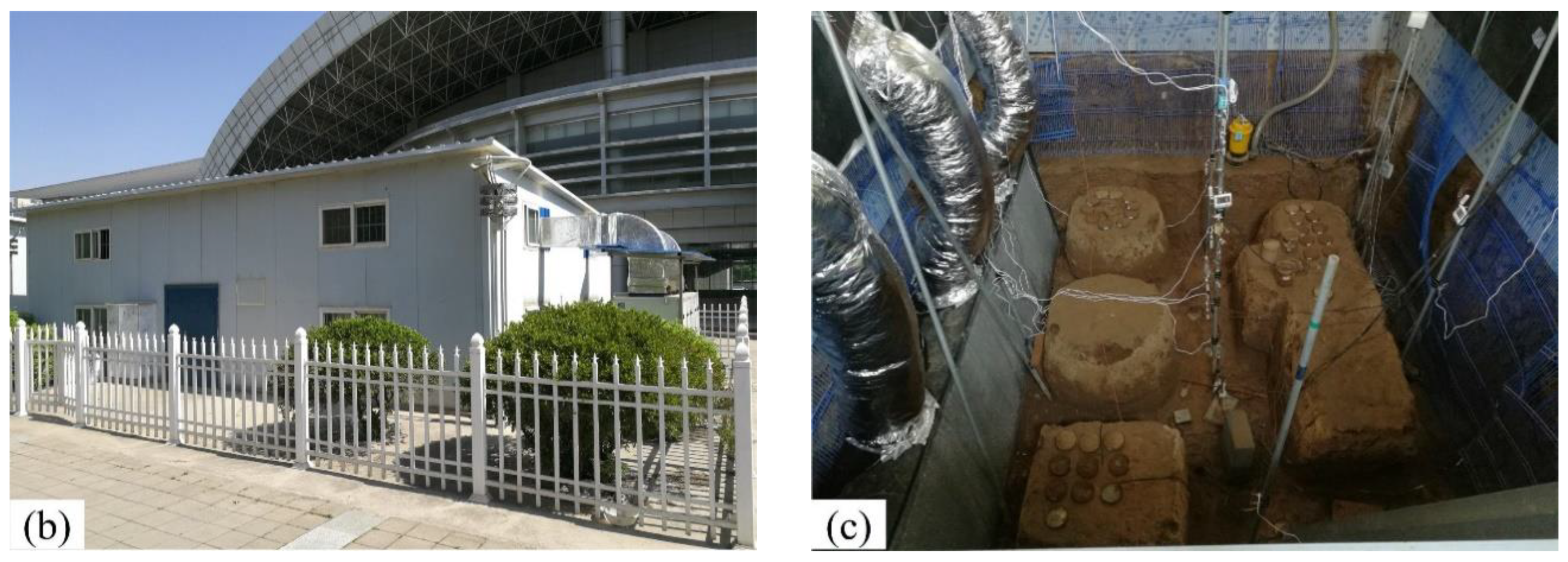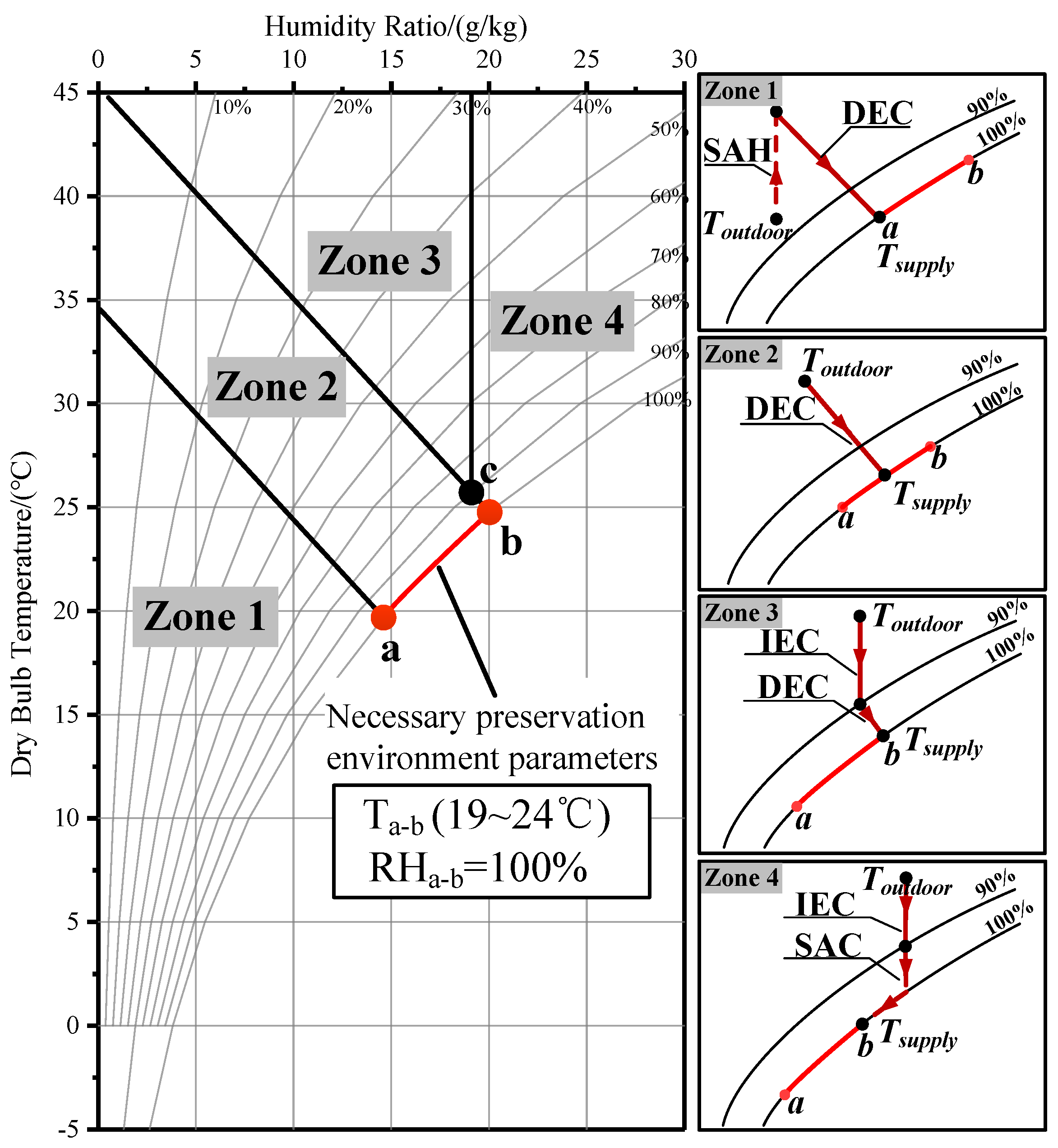1. Introduction
Global building energy consumption accounts for 36% of the total energy consumption [
1,
2], according to the statistics of the Building and Construction (2019) published by the International Energy Agency and Global Alliance. The building energy consumption in China accounts for 35% of the total domestic energy consumption with one-fifth of consumption originating from public buildings. Furthermore, the energy requirement for air conditioning is approximately 60% of the total energy consumed in buildings in many countries [
3,
4,
5,
6]. The traditional mechanical air conditioning equipment consumes substantial amount of fossil fuels for providing a comfortable indoor environment [
7,
8]. The traditional air conditioner produces two types of pollution, i.e., CO
2 emission from electricity generation system and greenhouse gases from chemical-based refrigerants [
9]. To reduce the associated global warming and environmental pollution, there is a need to increase the utilization ratio of clean and renewable energy and to improve the energy efficiency of large-scale buildings (e.g., office buildings, stadiums, museums).
Museums are common large-scale public buildings developed to preserve and display objects and collections. There are currently more than 5500 museums in China, with numerous archaeological museums constructed at the place where relics were unearthed [
10]. The exhibition halls of archaeological museum often have a large space with the unearthed historical sites that are semi-buried and semi-exposed to the air, such as the Emperor Qinshihuang’s Mausoleum Site Museum (
Figure 1). Accordingly, the environmental control of the archaeological museum faces two main issues. Firstly, a stable state of temperature and relative humidity (RH), and a balanced moisture exchange between soil and air is required for the preservation of historical relic sites [
11]. The traditional air-conditioning system in museums can provide a comfortable environment for tourists, yet they often cannot meet the specific environmental needs of earthen relic site [
12]. For example, most historical relic sites will suffer from seasonal cracking if they are preserved in these environmental conditions for longer period [
11]. Secondly, the indoor of archaeological museums is usually characterized by big space, broad layout, poor airtightness and low thermal resistance of walls, which results in high energy consumption of air conditioning system throughout the year [
13]. Taking the Emperor Qinshihuang’s Mausoleum Site Museum as an example, the estimated cooling energy consumption and cooling load index exceeds 2860.66 kW and 179 W/m
2, respectively [
13]. Furthermore, the majority of the energy for cooling is used for the non-historical site area, as a historical relic site occupies only a small part of the exhibition hall.
Numerous researchers have conducted studies on the protection of historical sites and on the reduction of energy consumption in museums worldwide [
14,
15]. Ascione et al. [
16] conducted an energy-saving case study for multiple Heating Ventilation Air Conditioning (HVAC) systems in a modern museum and showed that altering the acceptable range of indoor RH can lead to energy savings of about 40%. Karin et al. [
17] proposed a new standard in the control of the museum environment according to the temperature parameters derived from the adaptive thermal comfort model, and according to the RH parameters derived from ASHRAE. This study noticed about 15% savings in the electricity bill for the Amsterdam Museum. Luo et al. [
18,
19,
20,
21] proposed a variety of environmental control systems for preservation of historical relic sites (e.g., air curtain system, local displacement ventilation system, capillary radiation system) in China. These systems can effectively support the local environmental control for the historical relic sites and substantially reduce the energy consumption. Although these measures would influence the RH of the preservation environment and would attain a humidity of 80% or higher in order to reduce the drying rate of the historical relic sites, they cannot adequately protect the relics against desiccation cracking diseases caused by water transport between the coupled soil-air environment. The rationale behind this is that the transport of water from soil to air is a natural one-way process that is difficult to prevent only by increasing the RH [
12]. Adding liquid water directly to the soil is thought to be an effective way to suppress dry cracking and other problems such as seasonal cracking in historical sites [
12].
Evaporative cooling is a high-efficiency and energy-saving air conditioning technology that uses water evaporation to absorb and remove heat [
22]. When compared to the traditional air conditioning systems, the evaporative cooling system needs only about a quarter of the electricity consumed by a mechanical air conditioning vapor compression system [
23]. Chen et al. [
24] designed a hybrid system consisting of an indirect evaporative cooler (IEC) and wet-dehumidification desalination (HDH) for simultaneous production of low-temperature freshwater. Oh et al. [
25] proposed a detailed mathematical model to analyze the counter-flow indirect evaporative cooler with two different purge ratios. Furthermore, Shahzad et al. [
26] proposed an improved indirect evaporative cooler system for sensible cooling that can be combined with the dehumidification processes in order to achieve sustainable cooling goals. Evaporative cooling is generally divided into two types: (1) indirect evaporative cooling (IEC), and (2) direct evaporative cooling (DEC). In case of IEC, the supplied air is not in contact with water, and the cooling performance is affected by the temperature difference between the dry bulb temperature and the wet bulb temperature [
27]. For DEC, the supplied air is sufficiently cooled by spraying water through the air, which leads to the increase of moisture content in the air and it sometimes can even reach saturation point [
28]. According to JGJ 66-2015 [
29], the design code for Heating, Ventilation and Air Conditioning (HVAC) of Civil Buildings in China, RH in the indoor environment should be controlled within 70%, and therefore IEC is a more dominant air conditioning technology on the market [
29,
30]. However, evaporative cooling is rarely used in museums because RH values between 40% and 60% are generally required for the preservation environment of historical relic in museums [
29]. Nevertheless, high humidity is important for the preservation of historical relic sites in order to prevent them from drying and cracking. Therefore, the evaporative cooling system is one of the most effective ways for providing a stable preservation environment for the unearthed historical sites within an archaeological museum. An environmental control strategy that includes evaporative cooling system and ultrasonic humidification was proposed in order that the supply air reaches a supersaturated state.
Climate conditions are the most significant factors that affect the normal operation of evaporative cooling [
31]. Generally, the peak period for air conditioning and with high occurrence of seasonal cracking in the earthen sites in museums is summer. Therefore, there is a need to evaluate the applicability of the evaporative cooling in this period. Generally, the decrease in the air temperature is greater with the greater wet-bulb depression and the evaporative cooling system is more than effective [
32,
33]. However, the evaporative cooling for historical relic sites is insensitive to air temperature and has a specific requirement for RH [
34]. As the service objective of evaporative cooling changes from humans to historical sites, the standards for environmental control also change. Accordingly, the wet-bulb depression of the air is not the only criterion to evaluate the sustainability and the climate suitability of evaporative cooling systems.
In this paper, an environmental control system based on the evaporative cooling technology is proposed for the preliminary evaluation of the control effect on the preservation environment of the historical relic sites. An evaporative cooling applicability zone model was developed to analyze the efficacy of the evaporative cooling technology for different climates in China in order to provide a theoretical basis for the application of this technology in China’s archaeological museums.
2. High-Humidity Requirements for Preservation Environment of Historical Sites
Temperature and RH are the main factors influencing the preservation of historical sites [
35,
36] with countries worldwide having established standards that consider these factors. Based on the level AA environmental standards proposed by the American Society of Heating, Refrigerating and Air-conditioning Engineers (ASHRAE), the short-term changes in temperature and RH of the preservation environment should not exceed ±2 °C and ±5% RH, respectively [
37]. Furthermore, countries such as Italy and China, have further defined different temperature and RH thresholds according to the different materials of the collections [
38,
39,
40]. The environment for visitors and historical relic sites are listed in
Table 1. Due to the inorganic materials of the historical sites, they are insensitive to temperature and RH parameters [
41]. However, the environmental surrounding of the historical sites has changed from a moist, deep soil environment to a soil-air coupled environments as a result of the archaeological excavations [
42,
43]. Accordingly, the water content of the historical sites can be exposed to the air and is constantly evaporating, thus lowering the water content below the critical water content for cracking in the soil, which ultimately results in desiccation cracking disease (see
Figure 2). Therefore, inhibiting the loss of water and maintaining the original environmental condition of the historical relics is an effective solution for the problem of desiccation cracking. In order to maintain the original environment of the historical sites, RH of the preservation environment should be saturated. Therefore, by considering temperature and RH standards for the preservation environment of historical sites in various countries and by considering the high humidity requirements of historical sites, the preservation environmental parameters proposed in this paper are temperature (from 19 °C to 24 °C) and RH (saturation, 100%), with the temperature reference range having a minor difference during the actual museum environment control.
In this research, an environmental control system based on the evaporative cooling technology is chosen to meet the specific environmental requirements for the preservation of historical relic sites. The IEC would reduce outdoor air temperature to near dew point temperature, while the DEC would reduce air temperature and also changes RH to near saturation. Additionally, when compared to traditional mechanical refrigeration systems, evaporative cooling does not require additional power to provide a cooling source and therefore this technology has advantages for environmental control of historical relic sites.
5. Conclusions
In this paper, we investigated the effect of the evaporative cooling on the preservation environment of historical relic sites and further assessed the sustainability and the climate suitability of evaporative cooling technology by applying the evaporative cooling application zones model.
This study has found that the evaporative cooling system can maintain the preservation environment of earthen site in a stable, high humidity environment, which can effectively inhibit the water evaporation from historical sites. The short-term fluctuations of temperature and RH within the preservation area could be maintained at ±1.3 °C and ±0.0%, respectively, which conforms to the AA level of ASHRAE standard, and also satisfies the preservation requirements for inorganic relic materials in historic sites. Moreover, the evaporative cooling system has significant energy-saving benefits when compared to the traditional air conditioning mode.
This study also found that DEC and IEC + DEC modes have a high application potential in archaeological museums located in Xi’an, Chengdu, Hangzhou, and Wuhan. In addition, the proportion of evaporative cooling (DEC and IEC + DEC modes) usage exceeds 75% in Xi’an and Chengdu during the warm summer months of July and August. Therefore, the evaporative cooling has the most substantial energy savings potential in the archaeological museums in these two cities. On the contrary, evaporative cooling showed lower application potential in archaeological museums located in Guangzhou, Lanzhou, Urumqi, and Hohhot. These cities require additional usage of SAC or SAH to fulfil their air-handling demands. Therefore, the usage of energy efficient SAC or SAH would be important in these cities.



















